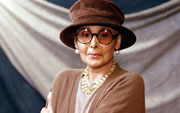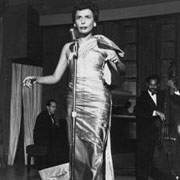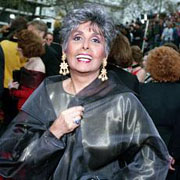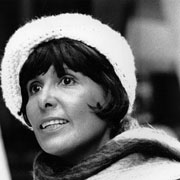VOA慢速英语2011--Lena Horne, 1917-2010: A Star Who Broke
时间:2019-01-12 作者:英语课 分类:2011年VOA慢速英语(十)月
PEOPLE IN AMERICA - Lena Horne, 1917-2010: A Star Who Broke Racial Barriers
BARBARA KLEIN: I’m Barbara Klein.
STEVE EMBER: And I’m Steve Ember with PEOPLE IN AMERICA in VOA Special English. Today we remember the singer and actress Lena Horne. She helped break racial barriers by changing the way black women were represented in film. During her sixty-year career performing, Lena Horne electrified 1 audiences with her beauty and rich, emotional 2 voice. She used her fame to fight social injustices 3 toward 4 African-Americans.
(MUSIC)
BARBARA KLEIN: That was Lena Horne singing her most famous song, “Stormy Weather.” She sang this song in a nineteen forty-three musical movie of the same name. In the nineteen forties, Lena Horne was the first African-American in Hollywood to sign a long-term contract with a major movie studio. Her deal with MGM stated that she would never play the role of a servant.
During this period, African-American actors were mostly limited to playing servants or African natives. Lena Horne refused to play roles that represented African-Americans disrespectfully.

Singer and actress Lena Horne who broke racial barriers as a Hollywood and Broadway star
STEVE EMBER: But this refusal 5 also limited her movie career. Horne was generally only offered the role of a nightclub singer. Her characters did not interact 6 with white characters in these movies. This way, her part could be cut from the version 7 of the movie that played in the American South. During this time, racial separation laws were in effect in the South.
Lena Horne later wrote that the movie producers did not make her into a servant, but they did not make her into anything else either. She said she became a butterfly pinned down and singing away in Movieland.
BARBARA KLEIN: Lena Horne once said that World War Two helped make her a star. She was popular with both black and white servicemen. She sang on army radio programs and traveled to perform for the troops. During one event, she noted 8 that German prisoners of war were permitted to sit closer to the stage than black soldiers. She criticized 9 the way black soldiers were treated by the army. These experiences led to Lena Horne’s work in the civil rights movement.

Grammy Award winner Lena Horne poses 10 with record producer Quincy Jonesand Dan Morgenstern of the National Academy 11 of Recording 12 Arts and Sciences
LENA HORNE: “When I went to the South and met the kind of people who were fighting in such an unglamorous fashion, I mean, fighting to just get someplace to sit and get a sandwich. I felt close to that kind of thing because I had denied it and had been left away from it so long. And I began to feel such pain again.”
(MUSIC: “Nobody Knows the Trouble I’ve Seen”)
STEVE EMBER: Lena Mary Calhoun Horne was born in Brooklyn, New York in nineteen seventeen. Her mother, an actress, was away for much of Lena’s childhood. Lena’s grandmother helped raise her. Her grandmother was a social worker and women’s rights activist 13.
At the age of sixteen, Lena found work as a dancer at the famous Cotton Club in New York City. After taking voice lessons, she soon began performing there as a singer.
BARBARA KLEIN: At the age of nineteen, Lena Horne moved to Pittsburgh, Pennsylvania and married Louis Jones. Her marriage did not last long. But she had two children, Gail and Edwin.

Lena Horne performs at the Sands Hotel in Las Vegas, Nevada in 1954
In nineteen forty, Lena Horne became the first African-American to travel and perform with an all-white jazz band. She also made records and performed at New York City’s Café Society jazz club. This was the first nightclub in the United States without racial separation. Many jazz clubs during this period had black performers. But few allowed black people to watch the shows in the audience.
STEVE EMBER: Lena Horne became very popular. After performing at a club in Hollywood, California, she caught the attention of filmmakers. She soon began making movies. Lena Horne said that she was able to make movies because she was the kind of black person that white people could accept. But she said this was the worst kind of acceptance 14. It was for the way she looked, not for how good she was or how hard she worked.

Lena Horne at the 65th Annual Academy Awards ceremony in Los Angeles, California in 1993
BARBARA KLEIN: In nineteen forty-seven, Lena Horne married Lennie Hayton. He was a music writer for the MGM movie studio and was white. The couple married secretly in Paris, France. They did so because it was illegal at the time for people of different races to marry in the United States. They did not announce their marriage for three years. Lena Horne later said that she first became involved with Lennie Hayton because she thought he could be useful to her career. He could help get her into places that a black manager could not. But she says she began to love him because he was a nice man.
(MUSIC: “Can’t Help Lovin’ That Man of Mine”)
STEVE EMBER: Lena Horne’s movie career slowed down in the nineteen fifties. But she continued recording and performing live and on television. Her nineteen fifty-seven album, “Lena Horne at the Waldorf Astoria,” became a best-seller.
She also became increasingly 15 involved in civil rights activities. She protested 17 racial separation at the hotels where she performed. She took action so that she and her musicians would be permitted to stay in those hotels. Black musicians at the time generally stayed in black neighborhoods.
Lena Horne also sang at civil rights gatherings 18. She took part in the March on Washington protest 16 in nineteen sixty-three. It was during this event that Martin Luther King Junior gave his “I Have a Dream” speech.
BARBARA KLEIN: Lena Horne performed in a strong and expressive 19 way. One expert said she was not warm and friendly like white, male singers at the time. Instead, she was a fierce, black woman.

The beautiful singer and actress is shown here in 1974 at the age of 57
Lena Horne once said she felt a need to act distant on stage to protect herself. She said when white audiences saw her, they were busy seeing their own idea of a black woman. She chose to show them a woman whom they could not reach. She said: “They get the singer, but they are not going to get the woman.”
(MUSIC: “I Want to Be Happy”)
STEVE EMBER: Lena Horne continued making records throughout the nineteen sixties, seventies and eighties. In nineteen eighty-one she returned to Broadway in New York with the show “Lena Horne: The Lady and Her Music.”
The show ran for over a year, before traveling around the United States and Europe. It earned her a Tony Award and two Grammy Awards.
BARBARA KLEIN: Lena Horne died in two thousand ten at the age of ninety-two. At the age of eighty, she said this about her career: “My identity 20 is very clear to me now. I am a black woman. I’m free.” She said she no longer had to be a “first” to anybody.
She said she did not have to act like a white woman that Hollywood hoped she would become. She said: “I’m me, and I’m like nobody else.”
(MUSIC: “The Lady is a Tramp”)
STEVE EMBER: This program was written and produced by Dana Demange. I’m Steve Ember.
BARBARA KLEIN: And I’m Barbara Klein. Transcripts 21, MP3s and podcasts are at voanews.cn. Join us again next week for PEOPLE IN AMERICA in VOA Special English.
- The railway line was electrified in the 1950s. 这条铁路线在20世纪50年代就实现了电气化。
- The national railway system has nearly all been electrified. 全国的铁路系统几乎全部实现了电气化。 来自《简明英汉词典》
- Emotional people don't stop to calculate.感情容易冲动的人做事往往不加考虑。
- This is an emotional scene in the play.这是剧中动人的一幕。
- One who committed many injustices is doomed to failure. 多行不义必自毙。
- He felt confident that his injustices would be righted. 他相信他的冤屈会受到昭雪的。
- Suddenly I saw a tall figure approaching toward the policeman.突然间我看到一个高大的身影朝警察靠近。
- Upon seeing her,I smiled and ran toward her. 看到她我笑了,并跑了过去。
- He persisted in his refusal to pay the money.他坚持拒绝付钱。
- Our offer was met with a firm refusal.我们的报价被坚决拒绝。
- All things are interrelated and interact on each other.一切事物互相联系并相互作用。
- The policeman advised the criminal to interact with the police.警察劝罪犯与警方合作。
- His version of the events is pure supposition.他对这件事的说法纯属猜测。
- What is your version of this matter?你对这件事情的看法 怎么样?
- The local hotel is noted for its good table.当地的那家酒店以餐食精美而著称。
- Jim is noted for arriving late for work.吉姆上班迟到出了名。
- The decision was criticized by environmental groups. 这个决定受到了环保团体的批评。
- The movie has been criticized for apparently legitimizing violence. 这部电影因明显地美化暴力而受到了指责。
- This poses a threat to agriculture and the food chain, and consequently to human health. 这会对农业和食物链造成威胁,由此而危及人的健康。
- The high cost of oil poses serious problems for industry. 昂贵的石油价格给工业造成了严重困难。
- This is an academy of music.这是一所音乐专科学院。
- I visited Chinese Academy of Sciences yesterday.我昨天去访问了中国科学院。
- How long will the recording of the song take?录下这首歌得花多少时间?
- I want to play you a recording of the rehearsal.我想给你放一下彩排的录像。
- He's been a trade union activist for many years.多年来他一直是工会的积极分子。
- He is a social activist in our factory.他是我厂的社会活动积极分子。
- The new laws gained widespread acceptance.新法令受到广泛赞同。
- It took years for Einstein's theory to gain acceptance.爱因斯坦的理论经过多年才被人们接受。
- Rivers are being increasingly made use of by man. 河流正在日益为人类所利用。
- I find it increasingly difficult to live within my income.我发现靠收入过日子越来越难了。
- I can't pass the matter by without a protest.我不能对此事视而不见,我要提出抗议。
- We translated his silence as a protest.我们把他的沉默解释为抗议。
- He protested he was being cheated of his rightful share. 他提出抗议说他被人骗取了他依法应得的份额。 来自《简明英汉词典》
- Amy protested she was being cheated of her rightful share. 艾米提出抗议,说有人骗取了她依法应得的份额。 来自《简明英汉词典》
- His conduct at social gatherings created a lot of comment. 他在社交聚会上的表现引起许多闲话。
- During one of these gatherings a pupil caught stealing. 有一次,其中一名弟子偷窃被抓住。
- Black English can be more expressive than standard English.黑人所使用的英语可能比正式英语更有表现力。
- He had a mobile,expressive,animated face.他有一张多变的,富于表情的,生动活泼的脸。
- He never revealed his identity.他从未暴露过自己的身份。
- He showed his identity card and went in.他把工作证亮了一下就进去了。
- Like mRNA, both tRNA and rRNA are transcripts of chromosomal DNA. tRNA及rRNA同mRNA一样,都是染色体DNA的转录产物。 来自辞典例句
- You can't take the transfer students'exam without your transcripts. 没有成绩证明书,你就不能参加转学考试。 来自辞典例句